
The Boletaceae are a family of mushroom-forming fungi, primarily characterised by small pores on the spore-bearing hymenial surface, instead of gills as are found in most agarics. Nearly as widely distributed as the agarics, the family is renowned for hosting some prime edible species highly sought after by mushroom hunters worldwide, such as the cep or king bolete . A number of rare or threatened species are also present in the family, that have become the focus of increasing conservation concerns. As a whole, the typical members of the family are commonly known as boletes.

Rubroboletus rhodoxanthus is a species of bolete in the family Boletaceae, native to Europe. Previously known as Boletus rhodoxanthus, it was transferred in 2014 to the newly erected genus Rubroboletus, based on DNA data.
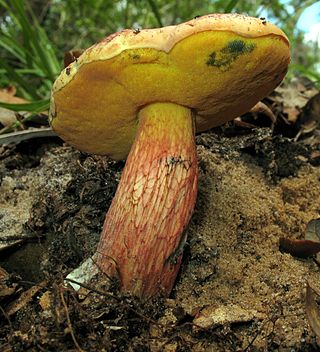
Exsudoporus floridanus is a species of edible bolete mushroom in the family Boletaceae. In 1945, American mycologist Rolf Singer described a species he found in Florida during his 1942–3 tenure of a Guggenheim Memorial Fellowship. He originally described it as a subspecies of the eastern North American species Boletus frostii, but later considered it worthy of distinct species status in a 1947 publication. Based on morphological and phylogenetic data, Vizzini and colleagues transferred this species to a newly described genus Exsudoporus in 2014. Due to lack of sufficient sequences, Wu et al. (2016) were reluctant to accept Exsudoporus and considered it a synonym of Butyriboletus, so they proposed a new combination Butyriboletus floridanus. However, following phylogenetic and morphological analyses clearly resolved Exsudoporus as a monophyletic, homogenous and independent genus that is sister to Butyriboletus.
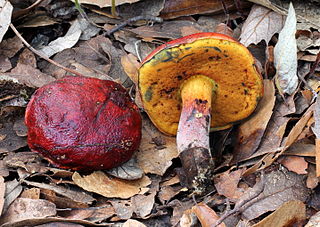
Rubroboletus dupainii, commonly known as Dupain's bolete, is a bolete fungus of the genus Rubroboletus. It is native to Europe, where it is threatened, and red listed in six countries. It also occurs in North America, although it is rare there. It was first recorded from North Carolina, and then from Iowa in 2009. It was reported from Belize in 2007, growing under Quercus peduncularis - a species of oak tree.
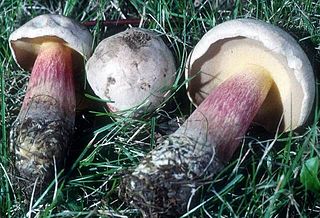
Caloboletus inedulis is a bolete fungus of the family Boletaceae that is native to North America. Until 2014, it was known as Boletus inedulis. Recent changes in the phylogenetic framework of the Boletaceae prompted the transfer of this species, along with several other related boletes, including Caloboletus calopus, to the genus Caloboletus. The species is inedible.

Caloboletus firmus is a bolete fungus native to North America. Until 2014, it was known as Boletus firmus. Recent changes in the phylogenetic framework of the family Boletaceae prompted the transfer of this species, along with several other related boletes, including Caloboletus calopus, to the genus Caloboletus. It was first described scientifically in 1874 by American botanist Charles Christopher Frost from specimens collected in New England.
Butyriboletus peckii is a fungus of the genus Butyriboletus native to eastern North America. It was first described by Charles Christopher Frost in 1878. Until 2014, it was known as Boletus peckii. Recent changes in the phylogenetic framework of the Boletaceae prompted the transfer of this species, along with several other related boletes, including Caloboletus calopus, to the genus Caloboletus. In 2015, Kuan Zhao and colleagues published analysis that demonstrated that the bolete belongs to Butyriboletus, closely related to Butyriboletus pulchriceps.
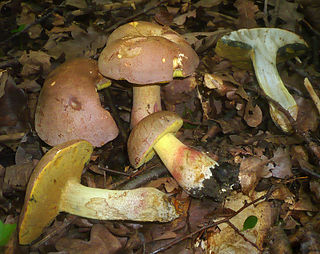
Butyriboletus fechtneri is a basidiomycete fungus in the family Boletaceae. It was formerly regarded as a species of Boletus, but in 2014 was transferred to the newly erected genus Butyriboletus, after molecular data revealed that it is a member of the "Regius" clade, quite distant from the core clade of B. edulis and closely allied species.

Lanmaoa is a fungal genus in the family Boletaceae. It was circumscribed by Chinese mycologists Nian-Kai Zeng and Zhu L. Yang in 2015 to contain several species formerly classified in the genus Boletus, as well as the newly described Asian boletes L. angustispora and L. asiatica. The erection of this genus follows recent molecular studies that outlined a new phylogenetic framework for the family Boletaceae. Zeng and Yang named the genus after Chinese naturalist Lan Mao (1397-1476).

Baorangia is a fungal genus in the family Boletaceae. It was circumscribed by Chinese mycologists Gang Wu and Zhu L. Yang in 2015 with B. pseudocalopus as the type species. Baorangia emilei and B. bicolor were transferred to the genus from Boletus that same year. The erection of Baorangia follows recent molecular studies that outlined a new phylogenetic framework for the Boletaceae. The generic name—derived from the Chinese words bao ("thin") and rang ("hymenium")—refers to the characteristically thin hymenophore, which distinguishes it from all other Boletaceae genera.
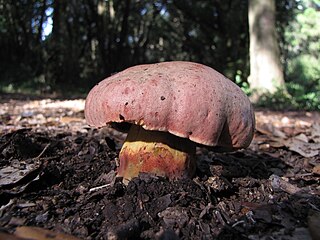
Rubroboletus lupinus, commonly known as the wolf bolete, is a bolete fungus of the genus Rubroboletus. Originally described by Elias Magnus Fries in 1838 as species of Boletus, it was transferred to Rubroboletus in 2015, a genus circumscribed to host other allied reddish-colored, blue-staining bolete species forming a distinct clade. The species epithet is derived from the Latin word lupus, meaning "wolf".

Rugiboletus is a genus of fungi in the family Boletaceae. It was circumscribed by Chinese mycologists Gang Wu and Zhu L. Yang in 2015 with the alpine species Rugiboletus extremiorientalis from eastern Asia as the type species. Rugiboletus brunneiporus of southern China and India was also described that same year. The erection of Rugiboletus follows recent molecular studies that outlined a new phylogenetic framework for the Boletaceae. The generic name—derived from the Latin stem rugi- ("wrinkled") and Boletus as the mushroom caps are wrinkled and furrowed, unlike any other boletes.

Neoboletus is a genus of fungi in the family Boletaceae, native to holarctic regions. It was circumscribed in 2014 by Italian mycologists Matteo Gelardi, Giampaolo Simonini and Alfredo Vizzini, and further by Chinese mycologists Gang Wu and Zhu L. Yang in 2015. Closely related to the genus Sutorius, members of this genus differ by staining blue when bruised. They have brown pores and lack a reticulated pattern on their stipes. The erection of Neoboletus follows recent molecular studies that outlined a new phylogenetic framework for the Boletaceae. The type species is Neoboletus luridiformis. Five species were added to the genus by Gelardi and Vizzini in 2014.

Caloboletus is a fungal genus in the family Boletaceae. It was circumscribed by Italian mycologist Alfredo Vizzini with Caloboletus calopus as the type species. The erection of Caloboletus follows recent molecular studies that outlined a new phylogenetic framework for the Boletaceae. Boletus peckii was also transferred to this genus by Vizzini, but was subsequently moved to the genus Butyriboletus based on molecular evidence. The generic name Caloboletus, derived from the Greek calos "nice", refers to the attractive red coloring of the stipe.
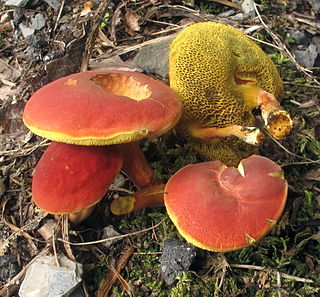
Hortiboletus is a genus of fungi in the family Boletaceae. It was circumscribed in 2015 by Giampaolo Simonini, Alfredo Vizzini, and Matteo Gelardi. The erection of Hortiboletus follows recent molecular studies that outlined a new phylogenetic framework for the Boletaceae. Hortiboletus is derived from the Latin word hortus "garden", referring to a typical habitat of the type species, Hortiboletus rubellus. The bolete H. bubalinus, originally described as a Boletus and later placed in Xerocomus, was transferred to the genus by Bálint Dima. In 2015, Alona Yu. Biketova transferred Boletus campestris and Boletus engelii to Hortiboletus.
Caloboletus panniformis is a bolete fungus native to Honshu island in Japan, where it grows under conifers in subalpine regions. Until 2014, it was known as Boletus panniformis. Recent changes in the phylogenetic framework of the family Boletaceae prompted the transfer of this species, along with several other related boletes, including Caloboletus calopus, to the genus Caloboletus. It was first described scientifically in 2013 by Japanese botanist Haruki Takahashi and colleagues.
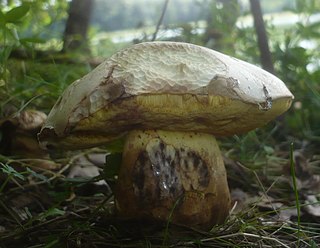
Caloboletus kluzakii is a bolete fungus native to Europe. Until 2014, it was known as Boletus kluzakii. Recent changes in the phylogenetic framework of the family Boletaceae prompted the transfer of this species, along with several other related boletes, including Caloboletus calopus, to the genus Caloboletus. It was described scientifically in 2006 by Josef Šutara and Pavel Špinar, from specimens collected in the Czech Republic. The fungus had earlier been published with the name Boletus fallax by Czech mycologist Zdeněk Kluzák in 1988, but this was invalid, as that name had been used previously by E.J.H. Corner for a Malaysian bolete. The epithet honours Kluzák's contributions in describing the species.

Hemileccinum impolitum is a basidiomycete fungus of the family Boletaceae, native to Europe. It is commonly referred to as the iodine bolete, because its fruit bodies tend to emit an iodine-like odour when cut, more detectable in the stem base or overripe specimens.
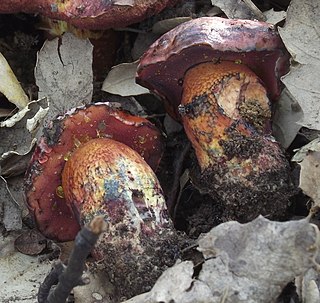
Exsudoporus is a genus of fungi in the family Boletaceae. It was circumscribed in 2014 by Alfredo Vizzini and colleagues, following a number of molecular studies that outlined a new phylogenetic framework for Boletaceae and revealed the genus Boletus in its traditional circumscription to be polyphyletic. However, due to lack of sufficient sequences, Wu and colleagues (2016) were reluctant to accept the newly proposed genus and considered it a synonym of Butyriboletus. Following additional phylogenetic sequencing and morphological analyses, Exsudoporus was clearly resolved as a monophyletic, homogenous and independent genus that is sister to Butyriboletus.
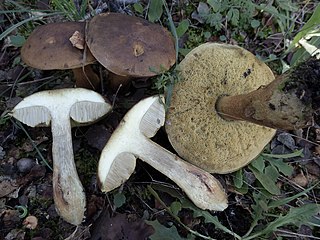
Leccinellum lepidum is a species of bolete in the family Boletaceae. Originally described as Boletus lepidus in 1965, the fungus has gone through controversial taxonomic treatments over the years and was subsequently transferred to genus Krombholziella in 1985, to genus Leccinum in 1990, and to genus Leccinellum in 2003. It is the sister-species of Leccinellum corsicum, with which it had been erroneously synonymised by some authors in the past.


















